2025
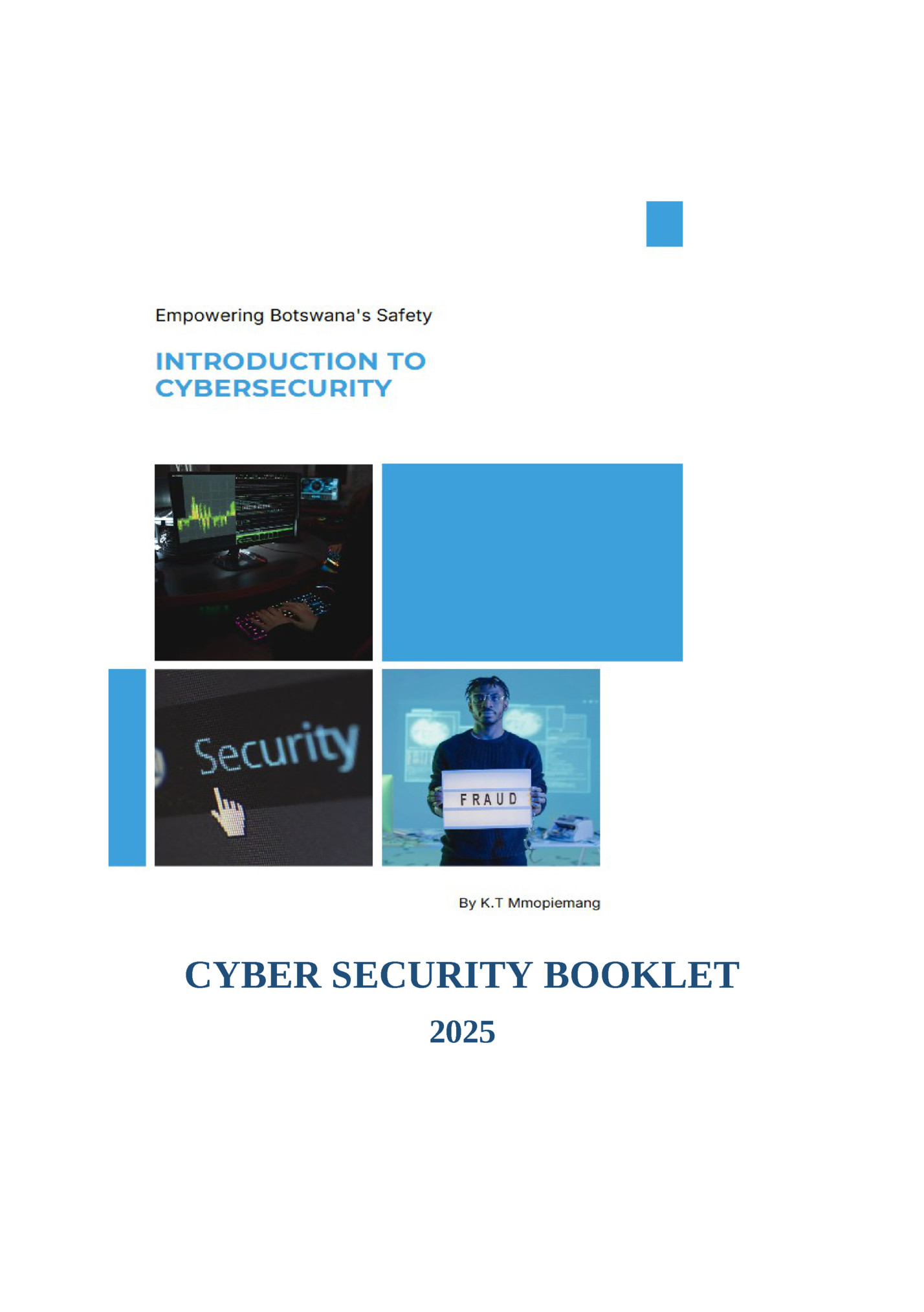
MODULE 1: INTRODUCTION TO CYBERSECURITY Cybersecurity encompasses the practices, technologies, and processes designed to protect computer systems, networks, programs, and data from digital attacks, damage, or unauthorized access. It involves establishing a robust security posture to safeguard information assets and ensure the confidentiality, integrity, and availability of critical systems and data. Cybersecurity aims to mitigate risks associated with cyber threats, which can range from simple malware infections to sophisticated, state-sponsored attacks. The field is constantly evolving to address new threats and vulnerabilities as technology advances. • Real-life examples of cyber incidents Cybersecurity is of paramount importance in today's digital world due to the increasing reliance on technology for nearly every aspect of life, from personal communications and financial transactions to critical infrastructure operations. The interconnectedness of systems and the vast amounts of sensitive data stored and transmitted online make individuals, businesses, and governments highly vulnerable to cyberattacks. Cybersecurity protects against financial losses, reputational damage, legal liabilities, and disruptions to essential services. It also safeguards national security and critical infrastructure. A strong cybersecurity posture builds trust in digital technologies and enables the continued growth and innovation of the digital economy.
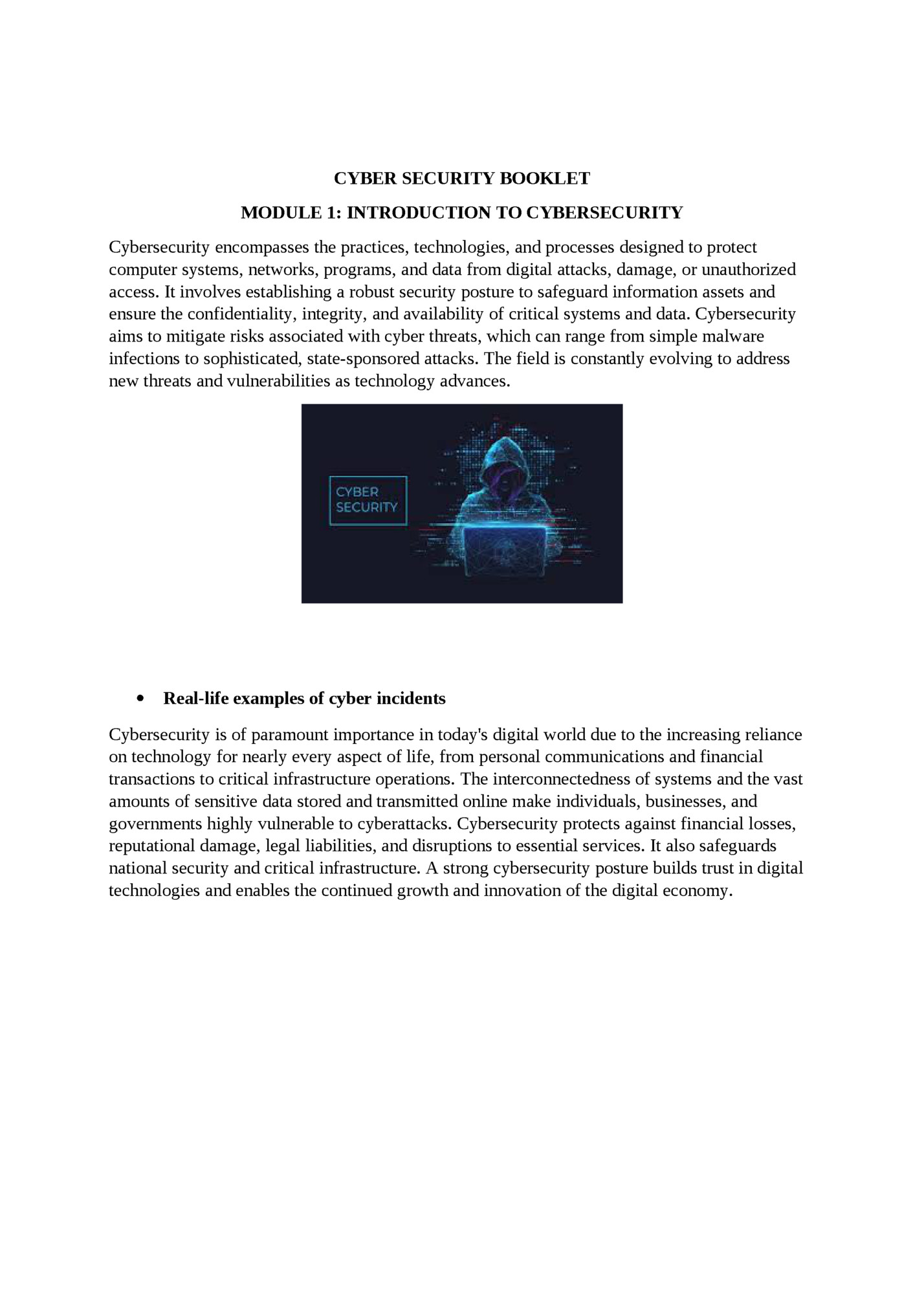
examples include: The CIA Triad is a fundamental model in cybersecurity, representing three core principles: Key concepts: CIA Triad (Confidentiality, Integrity, Availability) • Data breaches: Large-scale data breaches, such as the 2023 MOVEit Transfer vulnerability exploited by the Cl0p ransomware group, have exposed the personal and financial information of millions of individuals. These breaches can lead to identity theft, financial fraud, and reputational damage.
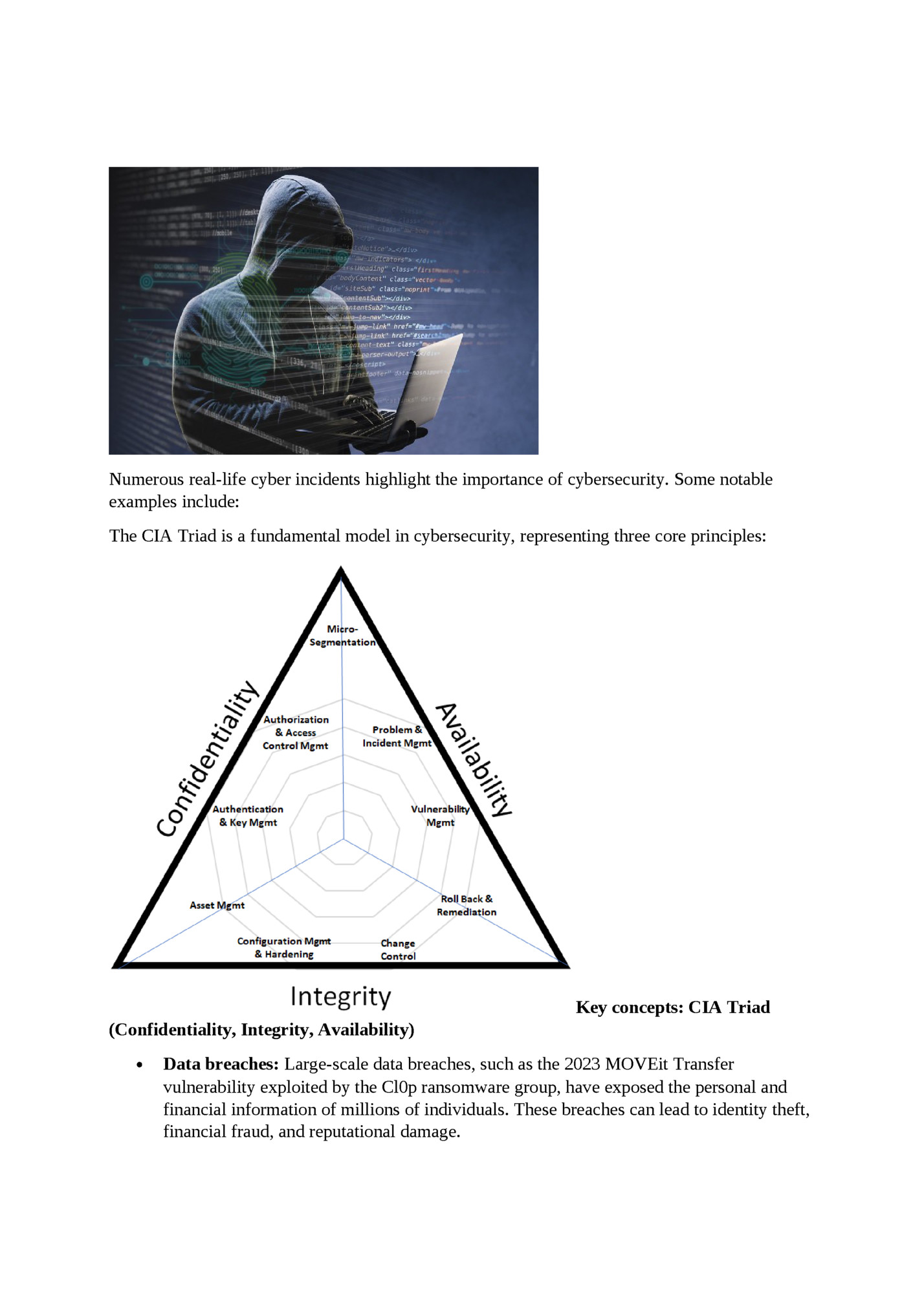
Ransomware attacks: Ransomware attacks, like the Colonial Pipeline attack in 2021, have disrupted critical infrastructure and caused significant economic damage.[4] These attacks involve encrypting data and demanding a ransom for its release. • Supply chain attacks: Supply chain attacks, such as the SolarWinds attack, have demonstrated how attackers can compromise software vendors to gain access to their customers' systems.These attacks can have a widespread impact and are difficult to detect. • Phishing campaigns: Phishing campaigns, where attackers impersonate legitimate entities to steal credentials or install malware, are a constant threat. These attacks can lead to financial losses, data breaches, and reputational damage. • Confidentiality: Ensuring that sensitive information is accessible only to authorized individuals or systems. This involves implementing access controls, encryption, and other measures to protect data from unauthorized disclosure. • Integrity: Maintaining the accuracy and completeness of data and preventing unauthorized modification or deletion. This involves implementing data validation, version control, and other measures to ensure data integrity. • Availability: Ensuring that authorized users have timely and reliable access to information and resources when needed. This involves implementing redundancy, disaster recovery plans, and other measures to ensure system availability. MODULE 2: TYPES OF CYBER THREATS AND ATTACKS The CIA Triad provides a framework for developing and implementing cybersecurity strategies that protect information assets. Malware (malicious software) is a broad category of software designed to harm or exploit any programmable device, service or network.Different types of malware include:
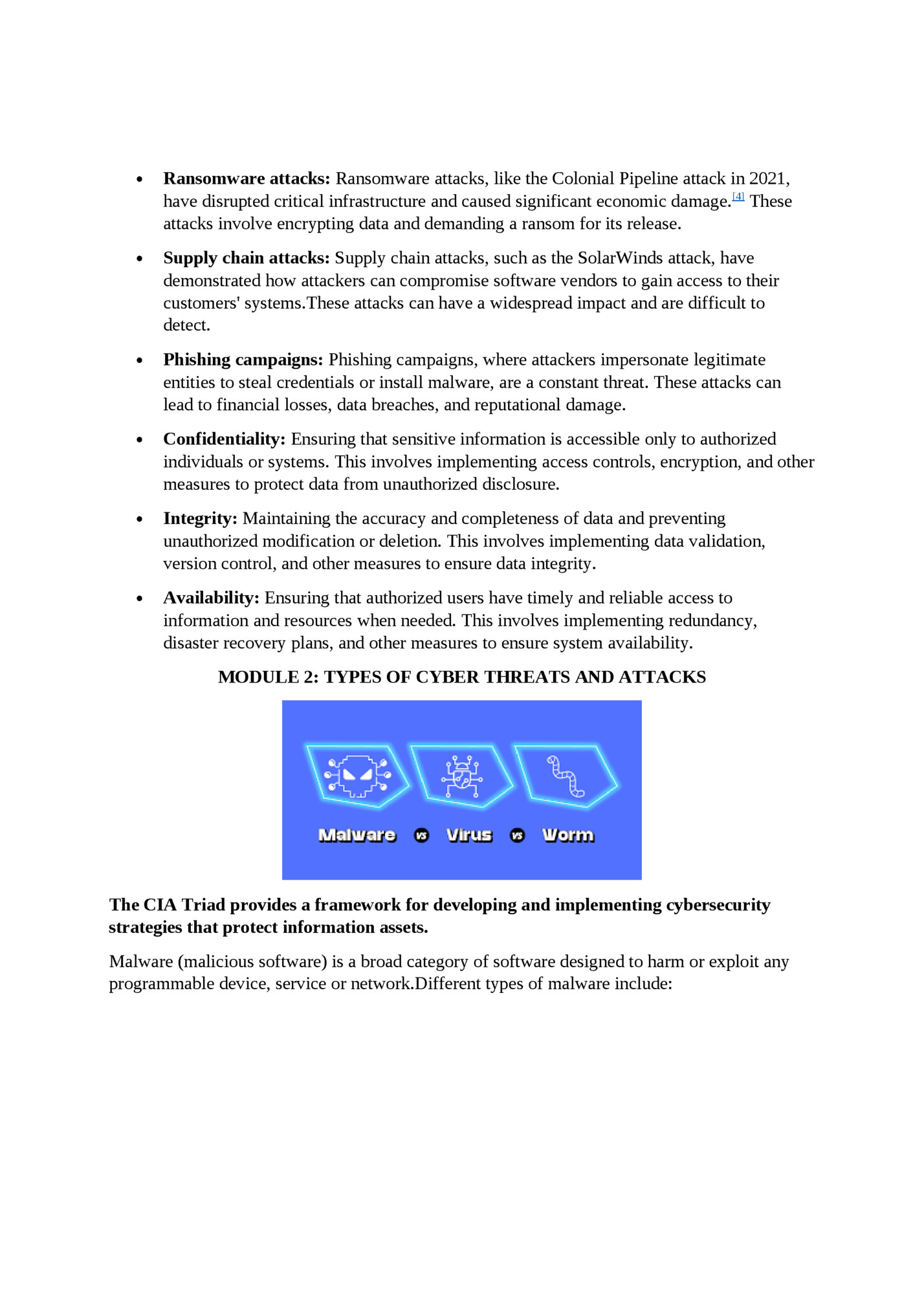
• Viruses: Programs that attach themselves to other files and spread by infecting other files or systems. • Worms: Self-replicating programs that spread across networks without user interaction. • Ransomware: Malware that encrypts a victim's data and demands a ransom for its release. • Spyware: Software that secretly monitors a user's activity and collects sensitive information. Password attacks involve attempts to gain unauthorized access to accounts by cracking or bypassing passwords. Common password attack methods include: Password attacks Phishing is a type of social engineering attack that uses deceptive emails, websites, or messages to trick individuals into revealing sensitive information, such as usernames, passwords, and credit card details.Social engineering involves manipulating individuals to gain access to systems or information. Attackers often use psychological tactics to exploit human vulnerabilities. • Brute-force attacks: Trying every possible password combination.
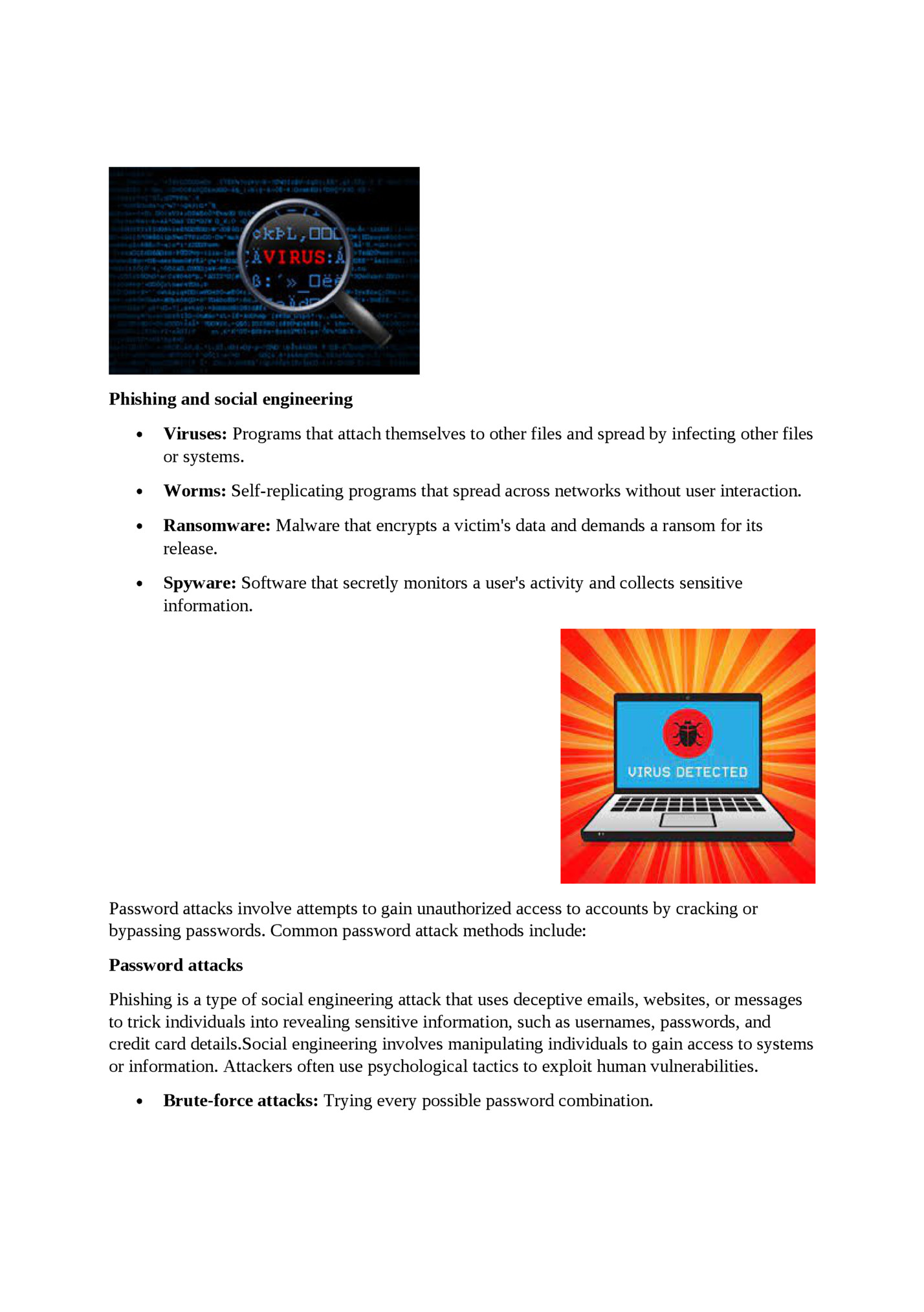
Dictionary attacks: Using a list of common passwords. • Credential stuffing: Using stolen credentials from one breach to attempt access to other accounts. • Password spraying: Trying a few common passwords against many accounts. Denial of Service (DoS) attacks Insider threats A Denial of Service (DoS) attack aims to make a computer or network resource unavailable to its intended users. This is typically achieved by flooding the target with traffic, overwhelming its resources, and causing it to crash or become unresponsive. Distributed Denial of Service (DDoS) attacks involve multiple compromised systems to launch the attack. Strong passwords and multi-factor authentication (MFA) Module 3: Insider threats are security risks that originate from within an organization, such as employees, contractors, or partners who have access to sensitive information or systems. These threats can be malicious (intentional) or unintentional (due to negligence or error). Insider threats can involve data theft, sabotage, or the misuse of privileged access. Safe browsing and email hygiene Using strong, unique passwords for all accounts is a fundamental security practice. Strong passwords should be long (at least 12 characters), complex (including a mix of uppercase and lowercase letters, numbers, and symbols), and not easily guessable. Multi-factor authentication (MFA) adds an extra layer of security by requiring users to provide multiple forms of verification, such as a password and a code from a mobile app or a security key.
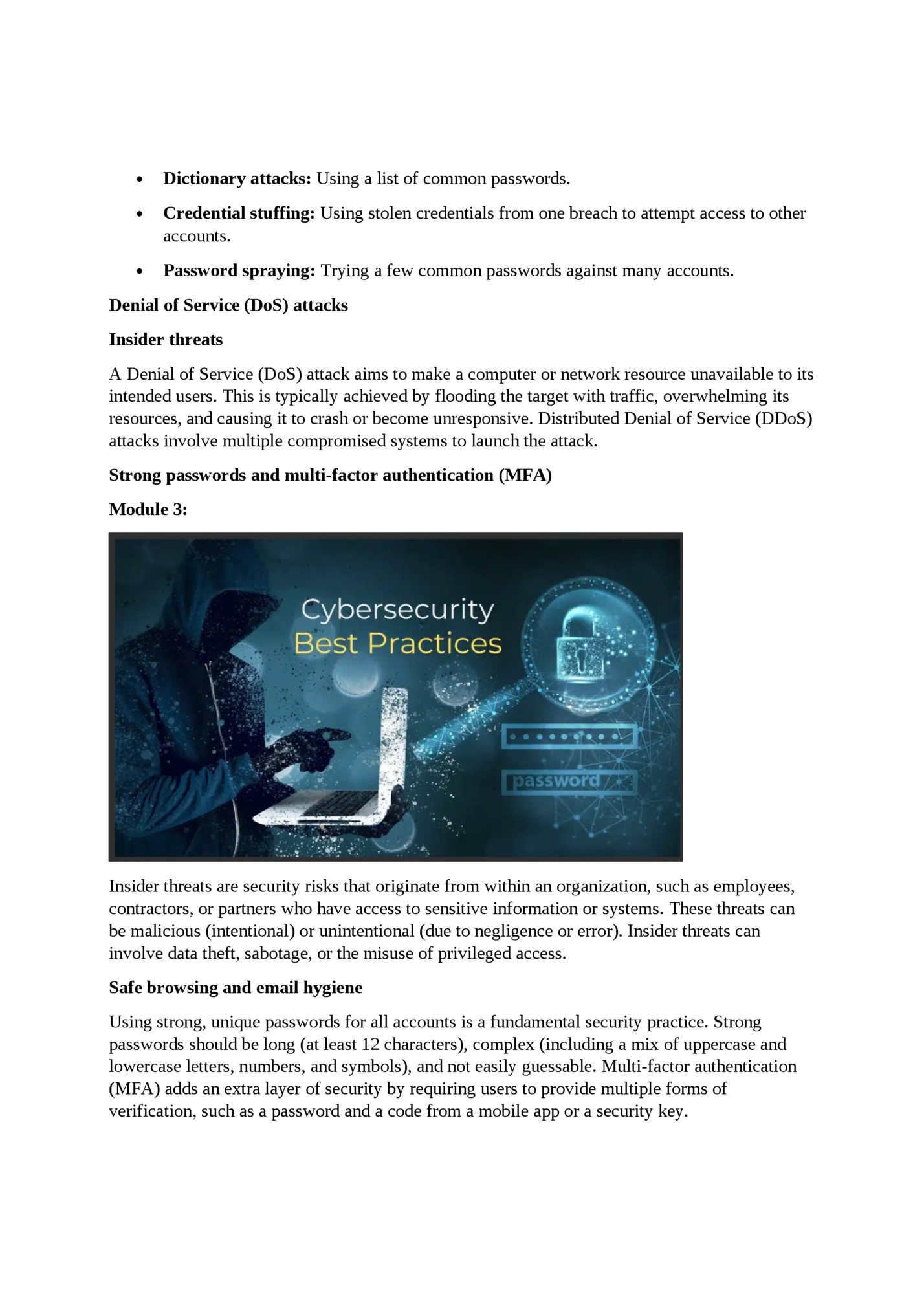
against cyber threats. This includes: Keeping devices and software secure involves several key practices: Device and software security (antivirus, updates) • Being cautious about clicking on links or opening attachments from unknown senders. • Verifying the authenticity of websites before entering sensitive information. • Keeping web browsers and email clients up to date. • Avoiding suspicious websites and downloads. • Using a secure search engine. Secure use of public Wi-Fi • Installing and maintaining up-to-date antivirus and anti-malware software. • Regularly updating operating systems, applications, and firmware to patch security vulnerabilities. • Using a firewall to control network traffic. • Enabling automatic updates whenever possible. • Using a VPN when using public Wi-Fi. Public Wi-Fi networks are often unsecured and can be vulnerable to eavesdropping and other attacks. To use public Wi-Fi securely: Backups and data protection • Avoid accessing sensitive information, such as banking details or personal data, on public Wi-Fi. • Use a virtual private network (VPN) to encrypt your internet traffic. • Ensure that websites use HTTPS (secure) connections. • Disable file sharing and other unnecessary services. • Encrypting sensitive data at rest and in transit. • Implementing access controls to restrict access to sensitive data. • Using data loss prevention (DLP) tools to monitor and prevent data breaches. Regularly backing up data is crucial for protecting against data loss due to malware, hardware failure, or other incidents. Backups should be stored in a separate location from the original data and tested regularly to ensure they can be restored. Data protection also involves:
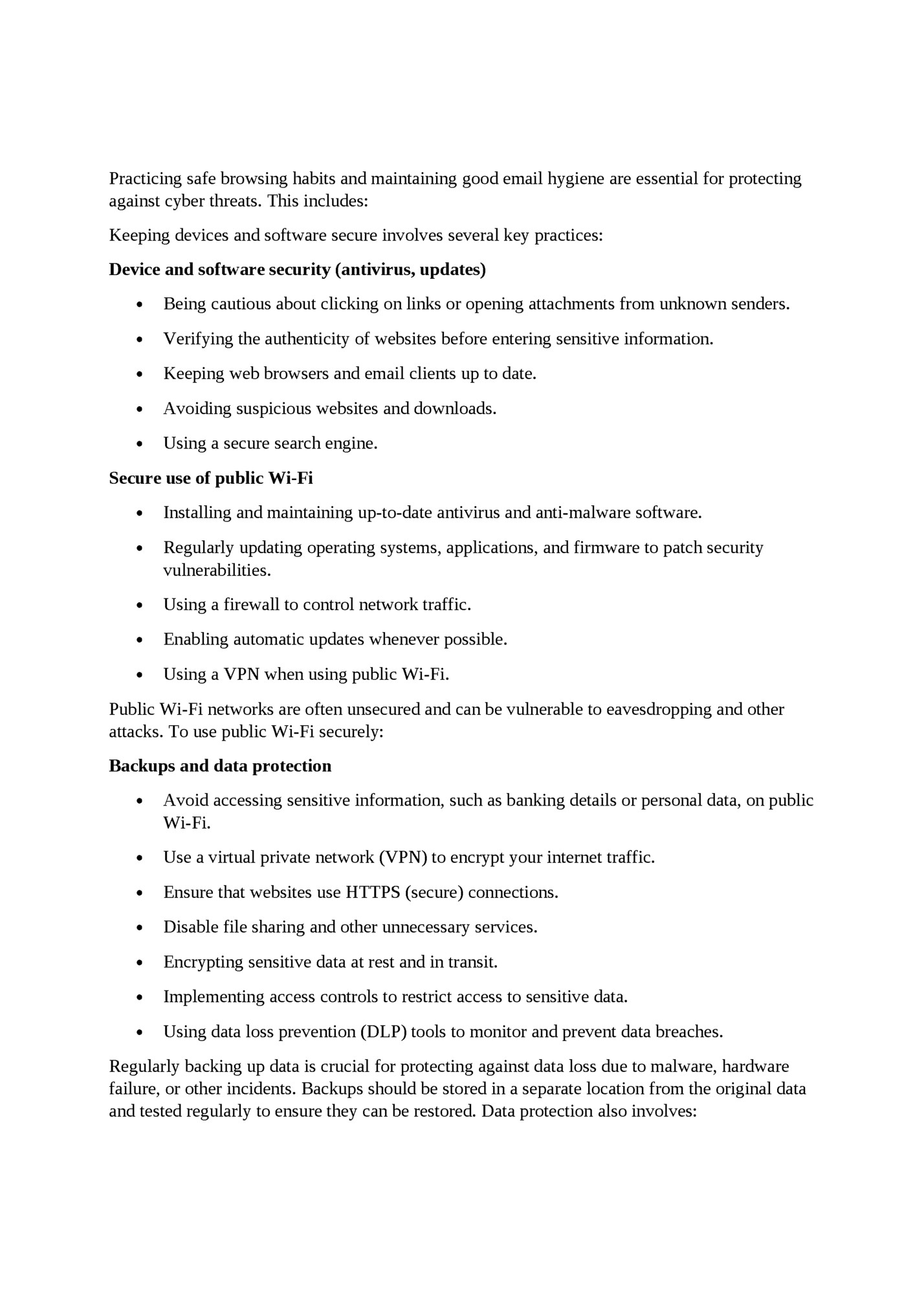
Various data protection laws and regulations govern the collection, use, and processing of personal data. Some prominent examples include: Introduction to data protection laws (e.g., GDPR, local data protection acts) Data privacy refers to the right of individuals to control how their personal information is collected, used, and shared. It involves protecting personal data from unauthorized access, use, disclosure, or modification. Data privacy is a fundamental human right and is increasingly regulated by laws and regulations around the world. Workplace cybersecurity involves implementing security measures to protect sensitive information and systems within an organization. This includes: Workplace cybersecurity and confidentiality • General Data Protection Regulation (GDPR): A comprehensive data protection law in the European Union that sets strict requirements for how organizations handle the personal data of EU residents. • California Consumer Privacy Act (CCPA): A state law in California that gives consumers the right to control their personal information. • Local Data Protection Acts: Many countries and regions have their own data protection laws that are similar to GDPR or CCPA. The ethical use of technology involves using technology responsibly and in a way that respects human rights, privacy, and other ethical considerations. This includes: Ethical use of technology
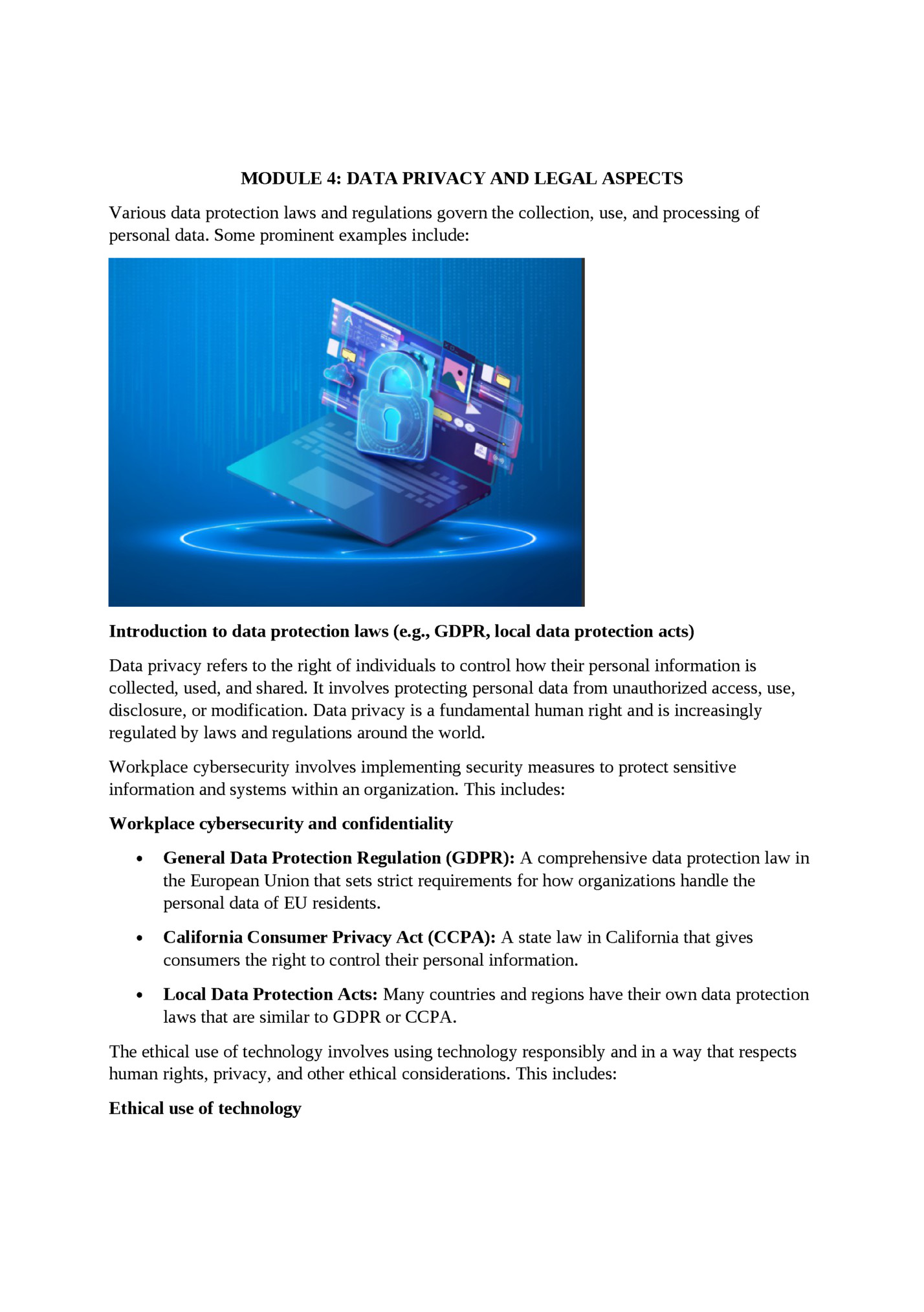
Establishing clear cybersecurity policies and procedures. • Providing cybersecurity training to employees. • Implementing access controls and data loss prevention measures. • Enforcing confidentiality agreements. Ethical considerations are increasingly important in cybersecurity, as organizations must balance security needs with the rights and expectations of individuals. • Avoiding the use of technology for malicious purposes. • Respecting the privacy of others. • Being transparent about how data is collected and used. • Considering the potential social and ethical implications of technology. MODULE 5: CYBERSECURITY IN THE WORKPLACE - TRAINING BOOKLET This training booklet covers essential aspects of cybersecurity within the workplace, focusing on roles, responsibilities, and incident response. Cybersecurity Roles and Responsibilities Every employee plays a vital role in cybersecurity. Key responsibilities include: 1. Individual Employee Responsibilities: Cybersecurity in the workplace is a shared responsibility, involving individuals at all levels of an organization. Understanding these roles and responsibilities is crucial for maintaining a secure environment.
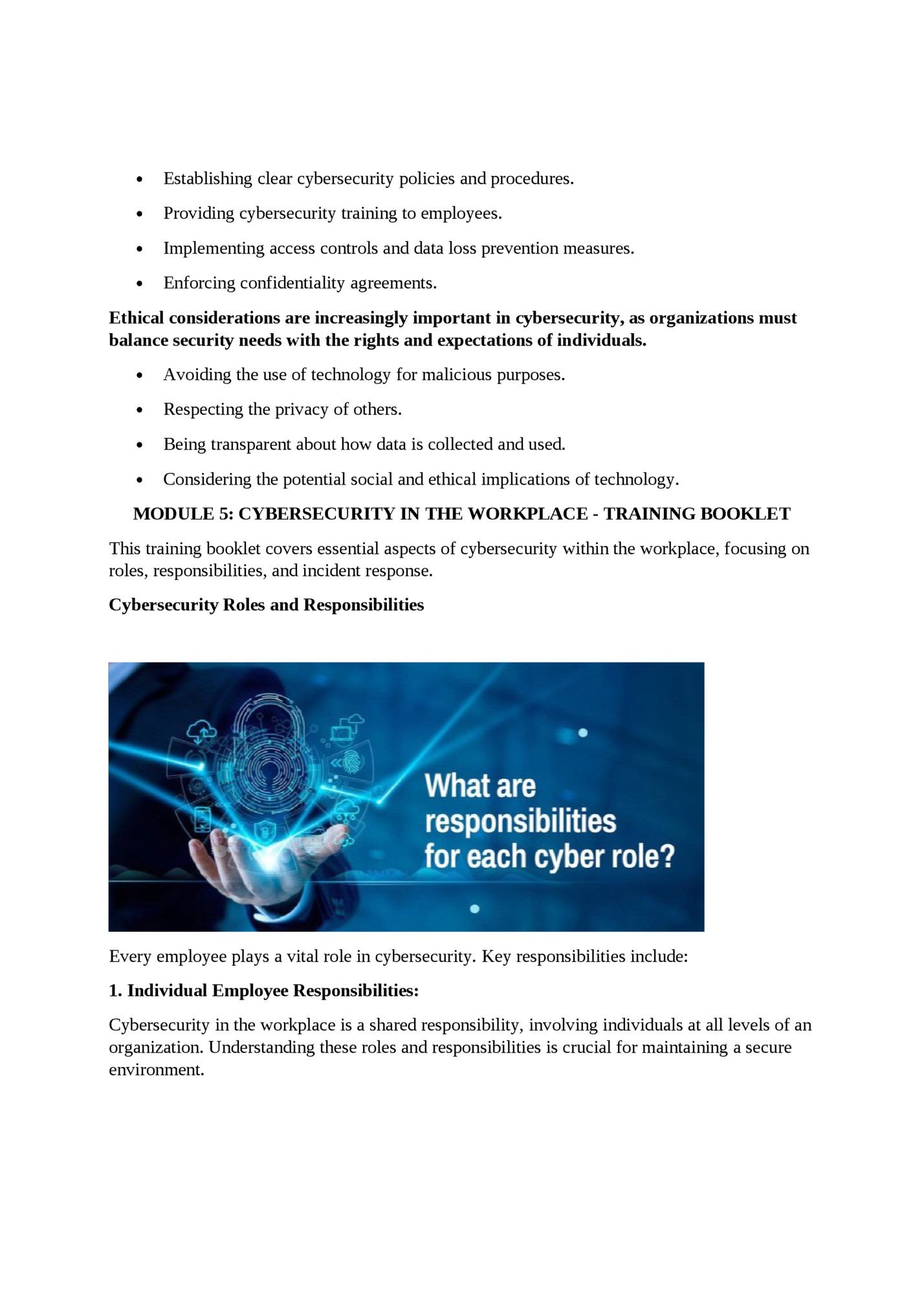
Fleepit Digital © 2021